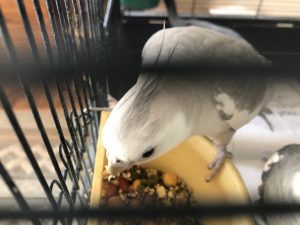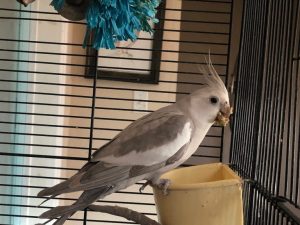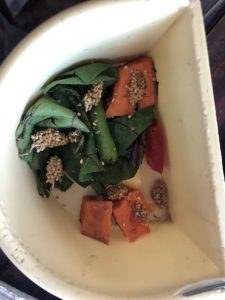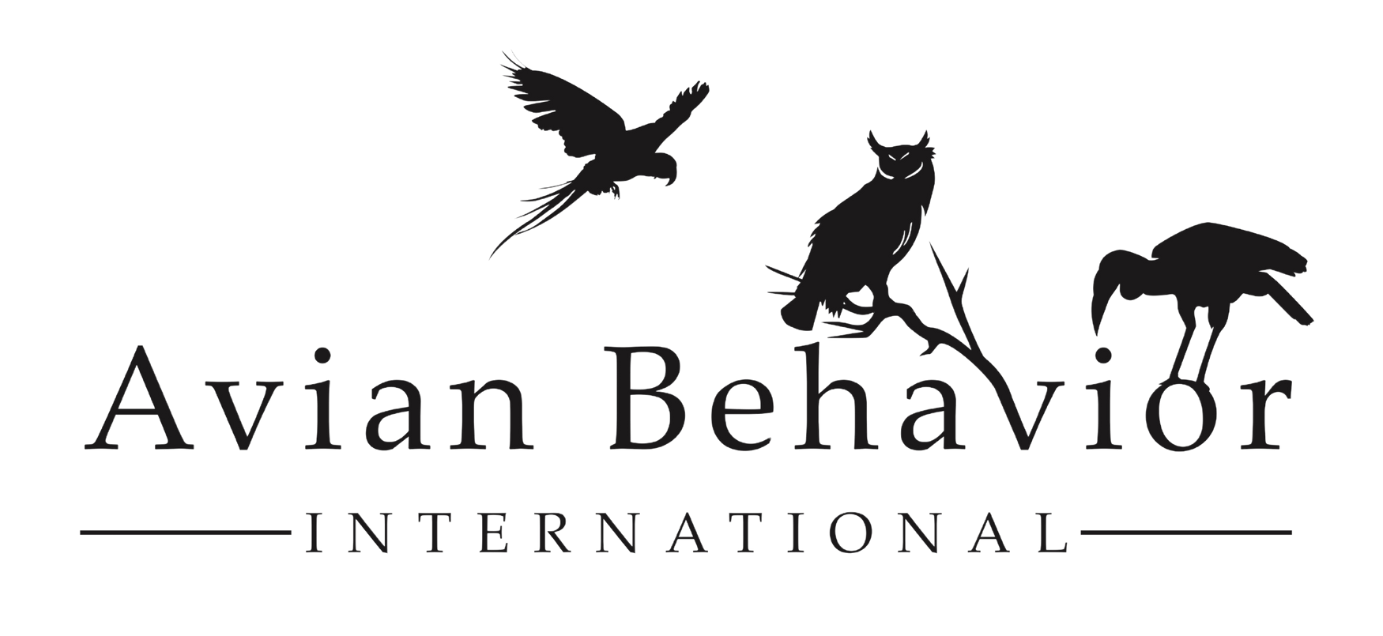
21 Nov Changing Your Parrot to a New Diet for Better Health and Behavior
You might have heard that a parrot on an all seed diet impacts its long term health and increases the bird’s risk for heart disease. It’s true, seed-based diets are lacking in many essential nutrients and are often high in fats. Parrots often become “seed junkies” and can become very difficult to wean off of seeds because seeds do taste good.
On the other side of the coin, some seed in your parrot’s diet isn’t bad either, much like eating a couple of potato chips isn’t terrible for us. What starts to get confusing is all of the information out there about what is the right diet for our parrots and their long term health.
Wild parrot diets
The truth is, we don’t know what parrots eat in wild, and honestly, they don’t always make the best choices. When left to their own devices, lories and lorikeets will pig out on sunflower seeds at the bird feeders! What we do know is that their  breeding cycles typically follow the availability of nutrient dense foods. When sugars and fats are plentiful, it signals their reproductive cycles to kick in to gear. In their native environments, they don’t have access to dense foods year-round, and often forage on fibrous, unripe foods with low sugars.
breeding cycles typically follow the availability of nutrient dense foods. When sugars and fats are plentiful, it signals their reproductive cycles to kick in to gear. In their native environments, they don’t have access to dense foods year-round, and often forage on fibrous, unripe foods with low sugars.
As their caregivers, we do almost the opposite: we feed them nutrient dense foods year-round. Their diets are often high in sugars and fats, and we lovingly dote on them with nuts, seeds, sugary fruits, and simple carbohydrates. This along with other factors, can put them in a constant state of reproductive hormonal activity (for more not this, our Avian Behavior Lab members can view our recorded webinar on Hormonal Behavior).
Foods to avoid with your parrot
Dr. Scott Echols, a board certified avian veterinarian with a strong field of research in nutrition and bone density, among other areas of study, stress the need to reduce fats and sugars in the diet, limiting fruits and essentially eliminating nuts. Even parrots such as hyacinth macaws that naturally consume higher fats in the wild have different caloric needs than our companion parrots, that are not exposed to nearly the amount of stress and exercise that their wild counterparts are. Reducing these dietary components can greatly impact a parrot’s risk of heart disease, which is one of the top medical problems parrots face in our homes. See the links below for more on his work.
Foods like bananas, apples, grapes, and other high glycemic index fruits should be offered at a minimum. Even corn has a lot of sugar in it, relatively speaking. Flour, rice, and milk sugars are other simple sugars are other common hidden sources of sugar that are often found in birdie breads and mixes that can be easily avoided as staples in your parrot’s diet.
a better diet for better behavior
There is another huge bonus to changing your parrot off of a mainly seed based diet. Here at Avian Behavior International, we will use a small amount of seeds for foraging toys and training to incentivize desirable behavior. This is important because we are using a food item that they don’t get often in order to add value to something that they might not otherwise do, such as step up, engage with shredding or destroying something while we are on the telephone or working with a nearby bird instead of screaming, and other important training sessions. If a parrot gets seed often or is on a seed-based diet, the likelihood it will engage in these other behaviors at the time we want them to is not as high as if these food items were more rare.
An example of this is the two cockatiels we are fostering, Gimlet and Goblin. They were on a seed diet when they came here, and we could also use millet for training. They did not know how to step up or even how to act outside of their cage  and would show a lot of anxious behavior, trying to fly around wildly without any flight skills. We needed a way to incentivize designated play areas outside of their cage to build positive history there, but it wasn’t until they started eating foods other than their seeds that we were able to make any real progress. Using a small amount of seed and graduated visits, we began teaching them confidence in spending more time outside of their cage and reduced the amount of panic flights.
and would show a lot of anxious behavior, trying to fly around wildly without any flight skills. We needed a way to incentivize designated play areas outside of their cage to build positive history there, but it wasn’t until they started eating foods other than their seeds that we were able to make any real progress. Using a small amount of seed and graduated visits, we began teaching them confidence in spending more time outside of their cage and reduced the amount of panic flights.
For a wonderfully deep dive into Dr. Scott Echols and my conversation on the benefits of parrot nutrition, why wild parrots’ diets aren’t always our best guide, and pelleted vs. raw diets, check out this podcast interview we recorded together. It is one of my favorite conversations to date and I’m sure you can feel my unbridled enthusiasm!
How to get your parrot on a better diet
Now that we have discussed why it is so important to get your parrot on a better diet, let’s talk about how!
The truth is, there are many different ways to get your parrot on a better diet, and all parrots are different with different tastes and experiences. We will go over our feeding regimen here and how we have been successful with some of our more stubborn tenants. First things first, no matter if you are trying to get your parrot to eat pellets or fresh produce, it’s going to take repetition. Your bird is going to keep needing to see the foods again and again. The second rule of the thumb I tell parrot parents is that a hungry parrot is not likely to try something new, so whatever method you choose, make sure it has access to its regular food even if in smaller amounts to ensure it feels comfortable but not too full.
The following tips work with a variety of different kinds of foods. We love feeding sprouts to our birds as they absolutely love them, our most hardcore seed junkies try them almost right away, and it makes it really easy for them to try other foods once we get them on sprouts. We also will over soaked and cooked grains that parrots on seed based diets will  more easily switch over to as well. One of my theories about this is because these food items look and taste similar to seeds and therefore a parrot is likely to try it. However, if you only have pellets, you can try this as well. For some of your more stubborn parrots, try crushing some of the pellets up into smaller crumbles (not too fine). Also, start with un-dyed, natural colored pellets. Some parrots may be put off by the brightly colored dyes in pellets that don’t look like the seeds they are used to.
more easily switch over to as well. One of my theories about this is because these food items look and taste similar to seeds and therefore a parrot is likely to try it. However, if you only have pellets, you can try this as well. For some of your more stubborn parrots, try crushing some of the pellets up into smaller crumbles (not too fine). Also, start with un-dyed, natural colored pellets. Some parrots may be put off by the brightly colored dyes in pellets that don’t look like the seeds they are used to.
Sprouts we like to use are chia, adzuki, mung, and garbanzo (chick pea). You can sprout many other types, even sunflower and pumpkin seeds, wheat berries, and others.
Sprouting safely depends on your area. Warm, humid areas can promote bacteria and mold growth. You can purchase a sprouting kit or use a glass bowl. Rinse the dried beans very well. Add cold water over the beans in your bowl or jar until they are covered by an inch or two of water. Let sit for 12-18 hours. If you are in a humid area, you might add a squeeze of fresh lemon juice to ward off bacterial growth. We recommend against use grapefruit seed extract, as this can impact gut bacteria.
Grains can be soaked for 12-18 hours and cooked until soft. See Dr. Echols’ article for some ideas for recommended grains.
If your parrot only eats seed, mix the sprouts, cooked grains, or pellets in your parrot’s bowl. It can help to have a larger bowl so that you can really mix it up well, but for some birds, having a new food bowl can slow the process.
We typically offer our parrots their food in meals, once in the morning and once in the afternoon/early evening. This helps promote eating habits the prevent them from grazing all day and create a motivation of looking forward to their meals, much like we do and they do in the wild. They have to make an effort to get to the meals, rather than walk a few inches to satiate every few minutes. This can also help in the process of switching your parrot over, that they aren’t going to be as discerning and only pick through their favorite seed types, making it look like they ate more than they actually did and we continuously refresh the food bowl. In actuality they could just be eating one or two types of seeds, which is even worse for their health!
If your parrot does eat some kinds of produce, this is great! I often hear in my consulting practice that the parrot likes banana, apple or grape. While these aren’t great fruits because they are so high in sugar, we can work with this! I might work with something like this to get a bird on a better diet. Create a salad with some bits of familiar things, like the  aforementioned foods. Then I will chop other foods and mix them in, with a sprinkling of cooked grains, sprouts, and something else that the parrot eats, like pellets, if they eat them, or seeds if they don’t. I mix this really well and offer them this salad. Seeing the familiar items will help them dig in and potentially try the unfamiliar items, whether on purpose or accident. This is what we did with our cockatiels, who only would eat broccoli. Soon they were trying zucchini strips, bits of papaya, and are now trying other bits of produce.
aforementioned foods. Then I will chop other foods and mix them in, with a sprinkling of cooked grains, sprouts, and something else that the parrot eats, like pellets, if they eat them, or seeds if they don’t. I mix this really well and offer them this salad. Seeing the familiar items will help them dig in and potentially try the unfamiliar items, whether on purpose or accident. This is what we did with our cockatiels, who only would eat broccoli. Soon they were trying zucchini strips, bits of papaya, and are now trying other bits of produce.
A few more diet change tips
Here are a few other tips to help your parrot through the transition:
If you have multiple parrots, this can help! Bravery comes through the flock, and whether or not the other parrots eat well, they can help each other try new things by eating together or near each other as a flock.
Keep trying! It can get disheartening to watch your parrot reject the food you keep preparing, but it does take time for your bird to see the new items as food. This is a survival mechanism.
Try different presentations. Our cockatiels tried zucchini when it was finally cut into thin strips. Try skewers, cubes, strips, threaded between bars, and in toys. Steam carrots, try them raw… there are many ways to offer your parrot food that will suddenly click.
If your parrot sees you eating food, it might try it too. Be careful, saliva from your mouth is not safe for your bird. Because they are communal eaters, you might offer a perch near a place you eat occasionally.
If you aren’t a member already, consider what a membership at the Avian Behavior Lab would do for your relationship with your parrot. An extensive, private community forum provides a safe opportunity to ask questions with experts and get feedback and behavior and wellness advice on challenges and queries big and small. Learn more about our memberships today!
Check out this podcast with Dr. Echols jam-packed information on foods and feeding your parrot for success!
http://www.avianstudios.com/wp-content/uploads/Foods-for-Different-Avian-Species3.pdf

